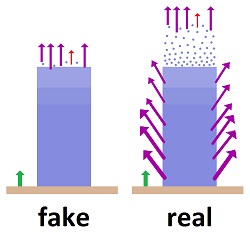The claim is commonly made that the atmospheric gradient of temperature from bottom to top is due to an adiabatic effect. Adiabatic means lower pressure of a gas due to expansion lowers the temperature with no heat being removed.
This concept is ridiculous for the atmosphere, because there has to be vertical convection to produce the expansion, and there is no large scale vertical convection in the atmosphere. Cumulous clouds are the only example, and they are rare. Even if not so rare, as some claim, they are not uniform, while the atmospheric gradient of temperature is extremely uniform. The absence of vertical convection is demonstrated by visible clouds. Vertical convection would mix the air and make the clouds disappear.
What then creates the uniform gradient of temperature with height? It would be the transfer of heat outward through absorption and re-emission of radiation. This process would be similar to conduction of heat through metal, but it is transfer of heat by radiation through a gas.
If a metal rod is heated on one end, there is a uniform gradient of temperatures to the other end. Radiation should move heat through the atmosphere in a similar manner, except that the radiation effect is much faster. Here are the reasons: Each molecule of metal takes up about a nanometer of space, which means 10 million per centimeter. The molecules must bump 10 million times to cover a centimeter. Air has about 860 times more space between each molecule. And when radiation is re-emitted, it travels much farther than to the next molecule. With greenhouse gases, radiation travels several meters before being re-absorbed. This means the energy travels about a billion times farther with each event for the air than for the metal, while each event would occur in about the same amount of time—the amount of time required for one vibration of the molecule.
This means heat could move from the surface of the earth to the top of the atmosphere very rapidly. At the top of the atmosphere, it would be emitted into space. This mechanism may be so rapid that it accounts for most of the earth's cooling.
I have been claiming that the planet is cooled by radiation which goes around greenhouse gases, which is 30% of the infrared, black body radiation. It's possible that radiation transmitted to the surface of the atmosphere does significant cooling due to its high speed. The faster the speed of transfer, the less gradient of temperatures. The large amount of gradient indicates a moderate speed.
